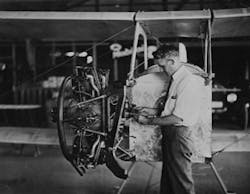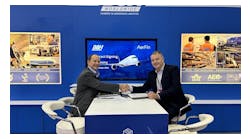Bert Kinner had a vision: He believed that private flying would be popular with millions of Americans, but remain a rich man’s activity until affordable engines were available. Toward that end he dedicated his life.
— John Underwood, Aviation Historian
Winfield Bertrum (“Bert”) Kinner was born in 1882, and raised on a farm in Iowa but was not destined to harvest crops or milk cows. His future was predetermined by his natural talents described by author John Underwood as “a self-taught wizard with things mechanical.” Although young, he sought work away from home at various jobs that didn’t stick. As a streetcar motorman, threshing machine operator, and as a barber, Kinner did not find his niche until the horse was replaced by transportation and farm equipment using the internal combustion engine.
During the Exhibition Era of pioneer aviation (prior to WWI) aviators traveled circus-fashion charging spectators 25 cents to see an aeroplane fly. In 1915, Kinner was operating a Cadillac agency with “a taxi stand on the side,” supporting his young wife, Cora (Brusse) and two children, Winfield Jr., and Robert (a daughter, Donna, was later born). Katherine Stinson was winging her way across Minnesota in her Wright machine, thrilling spectators with her stunts, about the same time Otto Timm was flying his home-built copy of a Curtiss Pusher. Forced to put down close to the Kinner’s home for repairs, fellow Minnesotan Timm fortuitously met Kinner, the mechanical wizard who was locally dubbed “the kid who could fix anything.” This chance meeting gave Kinner his first opportunity to work his wizardry on an engine (an Anzani) and introduced the two men who would become lifelong friends.
The “local kid who could repair anything,” felt a tug west and soon moved his family to Los Angeles, CA, where he customized Ford Model T Speedsters. He’d take beat up coupes and sedans and turn them into roadster,” says Underwood. Kinner was lured by accounts of WWI aces and intrigued by flight. He volunteered for the Air Service, albeit too late to serve. The war ended, but Kinner’s determination to fly had just begun. He studied publications on aircraft design, teaching himself how to build an aeroplane. At this point in time Kinner’s only experience with flight was an air tour with his family from a local airport. Undaunted, Kinner finished his home-built biplane with a second-hand 50-hp engine. It flew well enough for Kinner to teach himself to fly, but he had no desire to become a barnstormer. His plan was to build engines which were reliable yet inexpensive enough to put on the nose of an aircraft within reach of anyone who could afford an automobile.
Kinner Airport
Leaving the Model T business behind, he bought 210 acres in East Los Angeles, and called it Kinner Airport. He advertised automobile and aircraft repairs, and sold gas and hamburgers. Just like that, Bert Kinner entered “the game” of aviation.
From that point on, Bert Kinner never left California. In fact, he never left Los Angeles County.
No story about Bert Kinner’s contributions to aircraft and engine technology should be written without mention of his life partner, Cora Brusse Kinner. Underwood met Cora Kinner and her children a few years after Bert Kinner died. Through the ensuing years Cora shared the story of how Kinner engines and aircraft came about. Adventurous, smart, and loyal, she worked beside her husband, learning as he did. Their three children grew up helping with chores at the aircraft factory, on the airfield, and at home. “We all helped,” says Donna Kinner Hunter. “I remember the smells of engine oil, dope [a fabric shellac], kerosene, turpentine, and paint in the factory. Mom stitched fabric onto the airframes. My Uncle Lee (Cora’s brother, Lee Brusse) became dad’s test pilot. It was a family business with its ups and downs.”
Cora kept the books, supervised help, and hosted visiting guests. She was a familiar sight at the airfield, witnessing her husband’s test flights and the occasional accident. She took it all in stride. When their family business expanded they moved. When it failed, they moved. The Kinner household and factory were uprooted 10 times between 1915 and 1939. Cora outlived her famous husband by 25 years. “She never remarried after Bert’s death,” says Underwood.
The ups and the downs
Between 1919 and 1923 Kinner concentrated on building aircraft, the first being a biplane, the Kinner Airster, powered by a 60-hp Lawrence L2 engine. His “factory” was a former horse stable. By 1921 he was surrounded by females at Kinner Airport. In addition to his wife and daughter, he had a business hand-shake relationship with Neta Snook (“Snookie”) a mechanic, and sometimes flying instructor. Her ad at the field for “joyrides” drew in customers. Her student pilot was Amelia Earhart. In her biography of Earhart, Doris Rich observes, “Kinner saw nothing odd in a woman like Neta using his field for her Curtiss Canuck. She knew planes. She pumped gas and fixed shocks. She earned her keep.”
When Earhart showed up for flying lessons Donna recalls her mother wasn’t impressed by the skinny young woman in saddle shoes who had not yet become famous. “When mom asked Amelia what she liked to eat, she said ‘pork chops’. Mom cooked them, but grumbled about it.” Bert Kinner had a higher appreciation for Earhart than Cora. Earhart bought her first plane from Bert, the modified Airster, which she painted yellow and called the Canary. Kinner made it easy for Earhart to barter for repairs and hangar space on her meager income. She flew Kinner’s aircraft and later suggested improvements to his engine designs. Flying the Canary, she first entered the record books in 1921 reaching the women’s world altitude of 14,000 feet.
So comfortable was Kinner with women in aviation that a 1922 ad for his Airster ran this testimonial by Earhart: “A Lady’s Plane as Well as a Man’s.”
Although the Airster flew well, the high cost of engines inherently raised the price out of reach and sale orders were flat. “The price of an engine was the bugaboo,” says Underwood. Kinner focused on making an engine with a lower price tag, which would thereby make airplanes cheaper to buy.
The Kinners hung on through this period which Underwood describes as “R&D, mostly expense with little income.” They rented their home and moved into part of the hangar, and they rented the rest to airplane owners. While struggling to keep afloat, Kinner’s creative mind and spirit were unhampered. Impressed with European air-cooled engines built for use in WWI, he adapted them to tooling and tried to manufacture them inexpensively enough to go into production. Instead, says Underwood, “Only a few of the three-cylinder, 60-hp Kinners were built between 1922-1924. It was an excellent engine, but the scheme to economize on manufacturing didn’t work.”
Still optimistic, Kinner moved his hangar operations to the new Glendale Municipal Airport property and produced a less expensive version of the Airster, which created the buzz in aviation he had hoped for.
Again, sales were not forthcoming, and things looked grim but fate intervened in the form of a wealthy client who commissioned Kinner to build the one-of-a-kind Argonaut. Basically an Airster with a 200-hp Renault V-8 engine, the Argonaut made headlines (in 1924) when it transported couples through their wedding vows, becoming known as the “Honeymoon Special.” Kinner’s name was becoming well known, his Airster monoplane was in production, and the airport could always depend upon weekend tourists eager for a $5 air tour, or a drop-in student for a $10 flying lesson. Despite this progress, the business was precariously functioning, and it did not take much to tip the scales.
During 1925 the Kinner family’s finances and spirits were challenged with two debilitating events.
The man Rich describes as “restless . . . intent on the job at hand” became so ill with intestinal difficulties that he couldn’t work. With no income, Cora laid off employees and closed the shop.
Were this not bad enough, while Kinner convalesced, all his tools and supplies were stolen. With no insurance coverage, about all that was left of the business was the Kinner Airport sign.
His spirit undeterred, Bert Kinner did not take down his business sign and instead began designing aircraft and power plants of the future.
To be continued in the next issue of AMT magazine. Look for Part II “Bert Kinner — His Aircraft and Power Plants.



